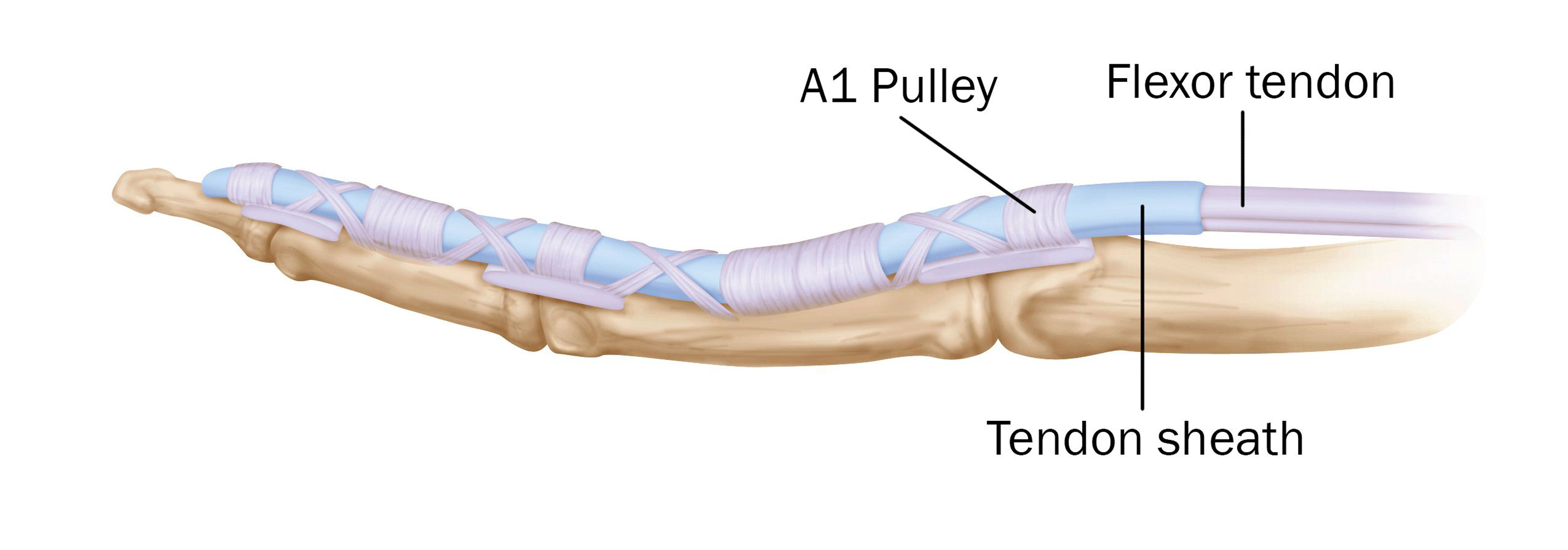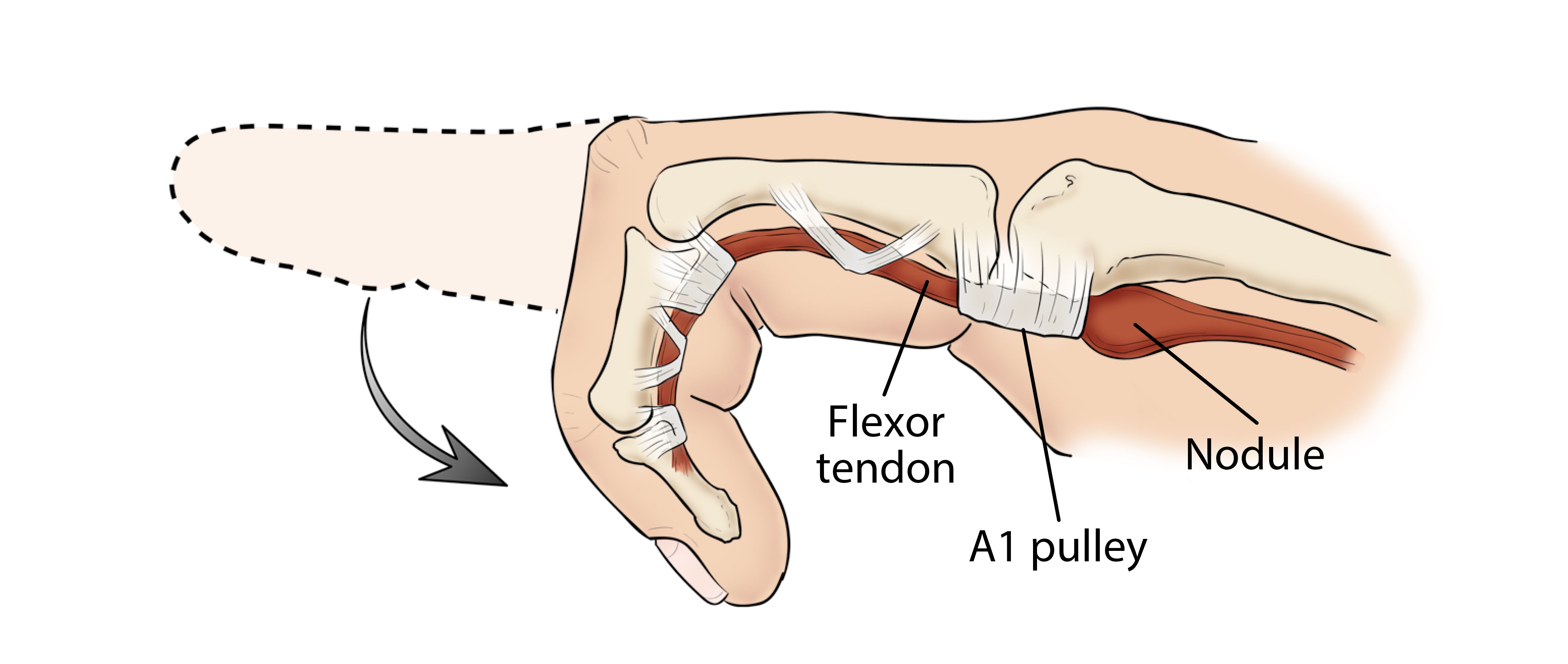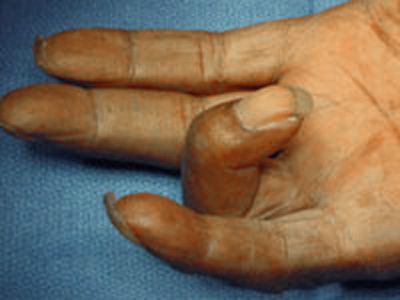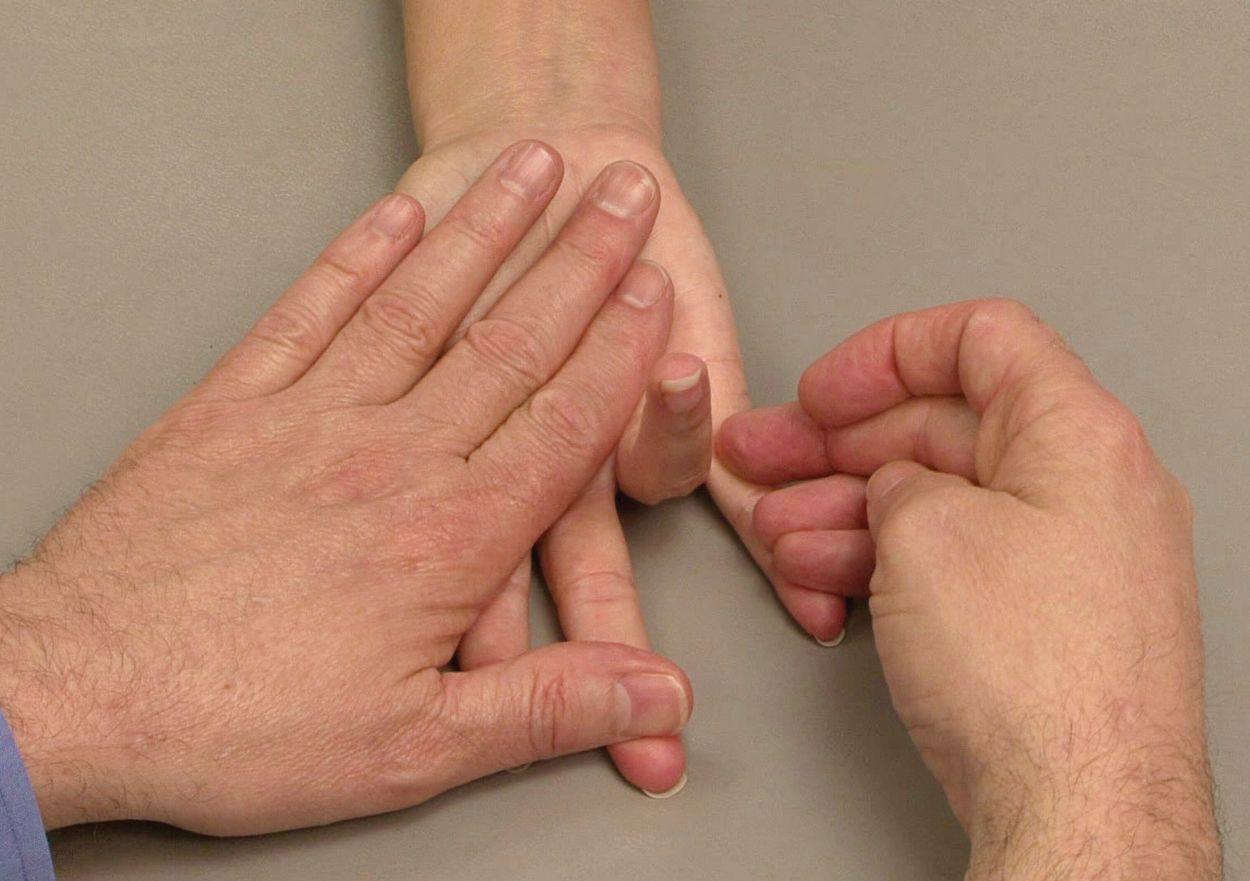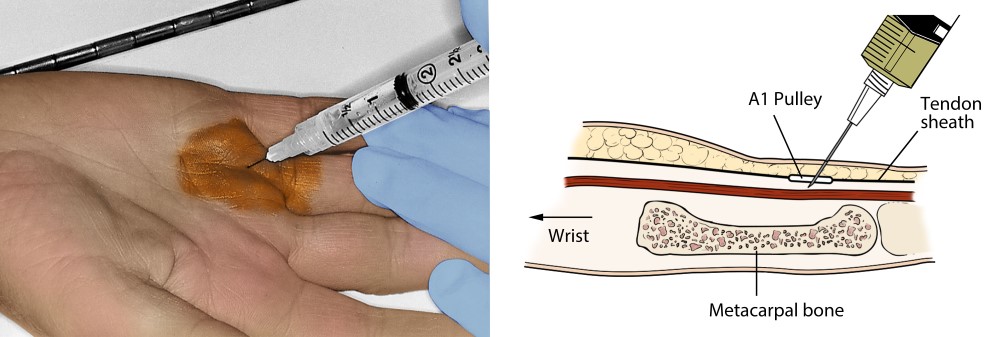Diseases & Conditions
Trigger Finger
Trigger finger is a condition affecting tendons that flex the fingers and thumb, typically resulting in a sensation of locking or catching when you bend and straighten your digits. Other symptoms may include pain and stiffness in the fingers and thumb. The condition is also known as stenosing tenosynovitis.
The ring finger and thumb are most commonly affected digits; however, the condition can affect any of the digits. When the thumb is involved, the condition is, appropriately, called trigger thumb.
Anatomy
The flexor tendons are long cord-like structures that attach the muscles of the forearm to the bones of the fingers and thumb. When the respective muscles contract, the flexor tendons pull on the bones of the fingers and thumb, causing them to bend.
Each of the flexor tendons to the fingers and thumb passes through a separate tubular structure, called a tendon sheath, as the tendon makes its way across the palm and into the digit. The tendon sheaths are firmly attached to the finger or thumb bones.
Along the tendon sheath, bands of tissue called pulleys hold the flexor tendons closely to the finger bones as the fingers flex and extend. The pulley at the base of each digit where the digit meets the palm is called the A1 pulley. This is the pulley that is most often involved in trigger finger. As long as the other pulleys are functioning, the A1 pulley can be sacrificed, if necessary, to treat a trigger finger.
Description
In a patient with trigger finger, the A1 pulley becomes inflamed and thickened, making it harder for the flexor tendon to glide through it as the finger bends. Over time, the flexor tendon may also become inflamed and develop a small nodule on its surface, further aggravating the condition. When the digit flexes and the thickened nodule passes through the tight pulley, there is a sensation of catching or popping. This is often painful.
In a severe case of trigger finger, the digit locks and becomes stuck in a bent position. Sometimes the patient must use their other hand to straighten the finger or thumb manually.
In the worst cases, the digit can't be straightened at all without intervention by a healthcare provider.
Cause
While the causes of trigger finger are not well known, several factors may increase your risk for developing the condition. These include:
- Medical conditions. Trigger finger is more common in people with certain medical conditions, such as diabetes and rheumatoid arthritis.
- Forceful hand activities. The condition is known to occur after forceful use of the fingers and thumb.
- Age. Trigger finger is more common in older individuals and is rare in children. However, there is a condition called congenital trigger thumb that can result in locked flexion of the child's thumb.
Symptoms
Symptoms of trigger finger often start gradually without a clear injury. They may follow a period of heavy or extensive hand use, especially pinching and grasping activities.
Symptoms may include:
- A tender lump at the base of the finger or thumb on the palm side of the hand
- A catching, popping, or locking sensation with finger or thumb movement
- Pain when bending or straightening the digit
Stiffness and locking tend to be worse after periods of inactivity, such as when you wake up in the morning. Symptoms may improve throughout the day with consistent, gentle use of the hand.
Doctor Examination
Your doctor will typically be able to diagnose a trigger finger by talking with you about your symptoms and examining your hand. Typically, X-rays or other tests are not absolutely necessary to make the diagnosis.
During the exam, your doctor will look for:
- Tenderness over the flexor tendon sheath in the palm of your hand
- Thickening or swelling of the tendon sheath at the base of your finger or thumb
- A clicking or catching sensation when you bend and straighten your finger or thumb
Treatment
Nonsurgical Treatment
Initial treatment for a trigger finger is usually nonsurgical.
Rest. Resting your hand and avoiding activities that make it worse may help to resolve the problem.
Splinting. Wearing a splint at night to keep the affected finger or thumb in a straight position while you sleep may be helpful.
Exercises. Gentle stretching exercises can help decrease stiffness and improve range of motion in the involved digit.
Medications. Over-the-counter medications, such as acetaminophen and nonsteroidal anti-inflammatory drugs (NSAIDs), can help relieve pain and inflammation.
Steroid injections. Corticosteroid, or cortisone, is a powerful anti-inflammatory agent that can be injected into the tendon sheath at the base of the affected digit. In many cases, a steroid injection can resolve the condition. If symptoms do not improve with one injection or improve but then come back after a period of time, a second injection may be given. If two injections do not help the problem, surgery is often recommended.
Steroid injections are less likely to be effective in patients with diabetes but may still help avoid surgery. They can cause a short-term rise in blood sugar, so glucose levels in diabetic patients should be monitored closely after injection.
Surgical Treatment
If your trigger finger does not get better with nonsurgical treatment, you may wish to consider surgery. The decision to have surgery is based typically on how much pain or loss of function you have in your digit. If, however, your finger or thumb is stuck in a flexed or bent position and cannot be straightened with gentle manipulation, your doctor may recommend surgery to prevent permanent stiffness.
Surgical procedure. The surgical procedure for trigger finger is usually trigger finger release.
The goal of the procedure is to release the A1 pulley, which is the pulley responsible for blocking tendon movement. After release, the flexor tendon can glide more easily through the tendon sheath, making the clicking/catching sensation go away. Typically, trigger finger release is an outpatient procedure, with an injection of local anesthesia to numb the area for surgery. It can be performed with or without sedation (medication that puts you to sleep).
Surgery is usually performed through either a small open incision in the palm or with the tip of a needle. The A1 pulley is divided (released) so that the flexor tendon can glide freely. Although pulleys have an important function in the hand, releasing the A1 pulley should not cause problems in the future, especially if the other pulleys remain intact.
Complications. Complications can occur with any type of surgery. Your doctor will discuss the risks with you before surgery and will take specific measures to help prevent complications.
The most common complications following surgery for trigger finger or trigger thumb include:
- Stiffness in the involved finger.
- Inability to straighten the involved finger. If you were not able to straighten your finger completely before surgery, you might not be able to do so afterward.
- Temporary soreness or swelling at the site of surgery.
Less common complications include:
- Persistent locking or clicking. This may indicate that more of the pulley needs to be released or may be caused by another problem in your finger.
- Bowstringing. In a small number of cases, the tendon may bow (bend, or curve) away from the bone, resulting in reduced range of motion. Bowstringing often occurs when one of the more important pulleys is released in addition to the A1 pulley.
- Infection (rare).
- Digital nerve injury. This may cause numbness or tingling along part of the finger.
Recovery. Most patients are encouraged to move their finger immediately after surgery.
It is common to have some soreness in your palm after the procedure. Elevating your hand above your heart can help reduce pain and swelling.
Although your incision will heal within a few weeks, it may take 4 to 6 months for swelling and stiffness in your hand and your fingers or thumb to go away completely.
If stiffness, swelling, or pain persist after surgery, your doctor may recommend seeing a hand therapist.
Outcome. The vast majority of patients who have surgery experience significant improvement in function as well as relief from the pain of a trigger finger. Still, if a contracture (abnormal shortening or tightening of tissues) or loss of motion was present before surgery, complete range of motion may not be fully restored.
Contributed and/or Updated by
Peer-Reviewed by
AAOS does not endorse any treatments, procedures, products, or physicians referenced herein. This information is provided as an educational service and is not intended to serve as medical advice. Anyone seeking specific orthopaedic advice or assistance should consult his or her orthopaedic surgeon, or locate one in your area through the AAOS Find an Orthopaedist program on this website.







